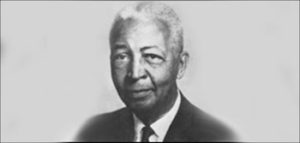
Lloyd Hall
On this date, in 1894, Lloyd Hall was born. He was a Black food chemist.
Lloyd Augustus Hall was born in Elgin, IL. His father was a Baptist minister, and his grandfather was one of the first Black preachers at the church where his father was a minister.
After attending high school in Aurora, IL., Hall received his Bachelor of Science degree from Northwestern University in 1914, a Master of Science from Northwestern in 1916, and a Doctor of Science from Virginia State College in 1944. Dr. Hall served as junior and senior Sanitary Chemist of Chicago's Department of Health laboratories from 1915 to 1919. From 1919 to 1921, he also served as chief chemist for John Morrell and the Company of Ottumwa, Iowa. He was president of the Chemical Products Corporation, Chicago, from 1921 to 1924.
Dr. Hall was a consultant for Griffith's Laboratories from 1925 to 1929, then as technical director and chief chemist of Griffith's Laboratories in Chicago (1929 –1946). From 1946 to 1959, Lloyd Hall served as technical director and assistant chief inspector of high explosives and research for the United States government during World War II. Dr. Hall was a consultant in the subsistence development and research laboratories of the Quartermaster Corps of the U.S. Army during World War II. He held over 100 patents in the United States, the United Kingdom, and Canada.
After his retirement, he became a consultant to the Food and Agriculture Organization of the United Nations. Lloyd Hall is responsible for many meat-curing products, seasonings, emulsions, bakery products, antioxidants, protein hydrolysates, and other substances that keep our food fresh and flavorful. Many of today's food preservative chemicals were developed through Dr. Hall's pioneering research. Before his discoveries, food preservatives were a matter of chance.
The most common preservative was a mixture of sodium nitrate and sodium nitrite. Preservation could be unreliable since excessive sodium nitrite made foods bitter and unpalatable, but insufficient nitrite would not protect against spoilage. Lloyd Hall developed a successful combination of complex chemical salts that have proved to be the most satisfactory curing salts marketed in this country. He developed new processes for sterilizing spices, cereals, other food materials, and pharmaceuticals, which are widely used today. In 1924, one of Hall's clients, Griffith Laboratories, entrusted him with his lab to complete some of his work. In 1925, he was appointed the chief chemist and director of research.
Lloyd Hall pioneered antioxidant use when he discovered that foods with fats and oils spoiled when certain ingredients react with oxygen in the air. He was the first to use lecithin, propyl gallate, and ascorbyl palmitate as antioxidants. He developed a process that made mixing these chemicals with food easier. One of his most successful products was an antioxidant salt mixture. His efforts in this area convinced Griffith Laboratories to open a large manufacturing facility devoted to protein hydrolysates.
People believed that spices preserved food, but Hall found that most spices, such as cloves, ginger, and paprika, contained large amounts of dangerous molds, yeast, and bacteria. Hall found ethylene oxide gas, a well-known insecticide that effectively destroyed food-borne microbes. He found a way to remove mixtures and gases by subjecting the food to a vacuum and adding ethylene oxide gas into a vacuum chamber. "Vacuum" sterilization treatment was later applied to drugs, hospital supplies, and cosmetics.
The 20th-century scientific contributions made by Lloyd Hall made him one of America's top food chemists. He died on January 2, 1971.
Just Like Me, Inc.
Books on African Americans
P.O. BOX 4494
Washington DC 20017
202.526.1725 or 888.586. BOOK